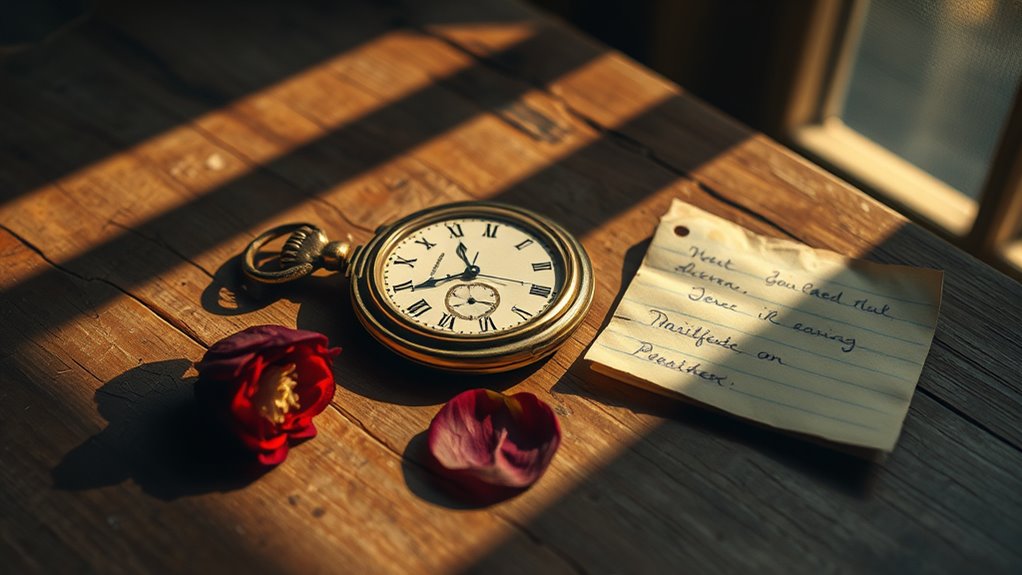“You could leave life right now” reminds you of memento mori, an age-old practice encouraging you to remember your mortality. Cultural symbols like skulls, hourglasses, and decaying objects serve as vivid reminders that life is fleeting. Embracing this awareness helps you focus on what truly matters, live with intent, and find peace. To understand how reflecting on mortality transforms your mindset and daily choices, explore what’s behind this powerful concept.
Key Takeaways
- Memento Mori encourages reflecting on mortality to live intentionally and appreciate the present moment.
- It serves as a reminder that life can end at any time, urging mindfulness and purpose.
- Symbols like skulls and hourglasses in art remind us of life’s fleeting nature.
- Embracing mortality fosters gratitude, resilience, and a focus on meaningful relationships.
- The practice aims to inspire living fully now, rather than postponing what truly matters.
The Origins of Memento Mori

The concept of memento mori dates back to ancient times, serving as a reminder of life’s fleeting nature. You might find roots in early Egyptian and Greek cultures, where symbols of mortality appeared in art and rituals. The Romans embraced it through stoic philosophy, emphasizing that death is inevitable and should influence how you live. During the Middle Ages, memento mori became prevalent in artwork, like skulls and hourglasses, to remind you to reflect on mortality regularly. These symbols encouraged a focus on spiritual preparation over worldly pursuits. Its origins highlight humanity’s universal acknowledgment of mortality, urging you to cherish each moment and live with purpose, knowing that life is fragile and finite. Additionally, modern AI-driven data analytics can help you understand patterns of mortality and inform your perspective on life’s impermanence, making the awareness of death a practical mindfulness tool. Recognizing the historical significance of memento mori can deepen your appreciation for the present and motivate meaningful actions.
Understanding the Meaning Behind the Phrase

At its core, the phrase “memento mori” serves as a powerful reminder of life’s impermanence. It urges you to recognize that death is inevitable, shaping how you live today. This awareness isn’t meant to induce fear but to inspire mindfulness and purpose. Think of it as a call to prioritize what truly matters, like relationships, passions, and integrity. The phrase encourages you to reflect on mortality regularly, influencing your choices and attitudes. Recognizing life’s fleeting nature can also serve as a reminder to appreciate the unique qualities and personalities of loved ones, including pets. Cultivating resilience and empathy in the face of life’s uncertainties can help deepen your connections and foster a more meaningful existence. Additionally, understanding the role of contrast in perception can enhance your appreciation of life’s precious moments and motivate you to live intentionally. Embracing mortality awareness can lead to a more intentional and fulfilling life, guiding your actions with clarity and purpose.
Historical Practices of Remembrance of Mortality

Throughout history, different cultures have used art and rituals to remind themselves of life’s fleeting nature. Medieval memento mori art, vanitas still life symbolism, and ancient ceremonies all served this purpose. These practices encourage you to reflect on mortality and embrace life’s transient beauty. Additionally, some traditions incorporate the use of butter in ceremonial offerings to symbolize the fleeting nature of material pleasures and the importance of spiritual over physical pursuits. The symbolism of recycled materials in various artifacts underscores the transient nature of material possessions and the cycle of life and death. Recognizing these symbols can deepen our understanding of cultural expressions related to mortality across different societies. Moreover, the use of natural materials in artifacts often emphasizes the connection between life’s impermanence and the natural world. Understanding death symbolism helps us appreciate how different cultures interpret mortality and the impermanence of existence.
Medieval Memento Mori Art
Medieval memento mori art serves as a vivid reminder of life’s fleeting nature and the inevitability of death. You encounter paintings, sculptures, and carvings designed to provoke reflection on mortality. These works often depict symbols like skulls, hourglasses, and decaying objects, emphasizing the transient nature of earthly life. Imagine:
| Symbol | Meaning | Visual Element |
|---|---|---|
| Skull | Death’s certainty | Resting on a mourner’s lap |
| Melting candle | Time slipping away | Dripping wax on a grave |
| Withering flower | Life’s fragility | Petals falling apart |
Through these images, medieval artists urge you to remember that death awaits all, no matter your status or wealth. They serve as constant reminders to live with purpose and humility.
Vanitas Still Life Symbolism
Vanitas still life paintings emerged during the 16th and 17th centuries as a powerful way to remind viewers of life’s fleeting nature. You’ll notice objects symbolizing mortality, like skulls, wilting flowers, and extinguished candles, which serve as visual metaphors for life’s impermanence. These symbols often serve as a visual reminder of the importance of appreciating the present moment. Fruits and clocks highlight the passage of time, emphasizing that life is temporary. Items like broken jewelry or empty shells remind you that material possessions are transient and ultimately insignificant. These symbols encourage reflection on mortality and the futility of worldly pursuits. By confronting these symbols, you’re prompted to contemplate your own mortality and prioritize spiritual or moral values over material success. Vanitas paintings serve as both a reminder and a call to live meaningfully before life’s inevitable end.
Rituals in Ancient Cultures
Ancient cultures actively practiced rituals to honor and remember mortality, viewing death as an essential part of life’s cycle. You might’ve participated in rituals like funeral processions, offerings, or memorial feasts that reinforced the transient nature of existence.
In Egypt, you’d have engaged in elaborate mummification and tomb rituals to guarantee safe passage into the afterlife, reflecting a deep awareness of mortality. These practices often incorporated traditional healing practices to ensure spiritual well-being and concepts of spiritual preservation.
The Greeks held symposia and painted memento mori images to remind themselves of life’s fleetingness. These artistic representations served as powerful symbols of mortality, encouraging reflection on human fragility.
In Mesoamerica, human sacrifices and ceremonies honored death as a gateway to renewal. Such practices emphasized the cyclical nature of life and death within their worldview. They also performed commemorative rituals to maintain social cohesion and collective memory around mortality.
These practices served to confront mortality directly, fostering reflection on life’s impermanence. They also reinforced social bonds and cultural values centered on remembering that life is fragile and death inevitable. Understanding the cultural significance of mortality rituals helps us appreciate how ancient societies processed their fears and reverence for death.
The Philosophical Roots of Living Mindfully

Living mindfully has deep philosophical roots that encourage us to focus on the present moment and recognize the transient nature of life. Philosophers like Socrates emphasized self-awareness and questioning, urging us to examine our lives daily.
Buddhism teaches that attachment causes suffering and advocates for living in the now to find peace. Stoics, such as Marcus Aurelius, remind us that life is fleeting and that accepting mortality leads to virtue and serenity.
These philosophies share a common thread: understanding life’s impermanence helps us prioritize what truly matters. By cultivating mindfulness, you align your actions with these ancient insights, embracing each moment fully. Recognizing the importance of floating on water demonstrates how modern spiritual awareness can also reflect these principles by fostering adaptability and present-focused innovation.
This awareness fosters gratitude, resilience, and a deeper appreciation for life’s fragile beauty.
How Memento Mori Influences Art and Literature

Memento Mori shapes art and literature by embedding symbols that remind viewers and readers of life’s fleeting nature. You’ll notice themes of mortality that provoke reflection and existential questions.
Artists and writers often use these motifs to motivate deeper contemplation of life’s purpose and impermanence.
Symbolism in Artistic Works
Because of its powerful reminder of mortality, the concept of memento mori has profoundly shaped artistic works across history. Artists embed symbols like skulls, extinguished candles, and wilting flowers to evoke life’s fleeting nature. These images serve as visual cues, prompting viewers to reflect on mortality. The symbolism creates a layered experience, blending beauty with transience. Imagine this:
| Symbol | Meaning | Effect |
|---|---|---|
| Skulls | Death, mortality | Invites reflection |
| Burning candles | Life’s brevity | Urgency to live fully |
| Withering flowers | Ephemeral beauty | Awareness of impermanence |
Through such symbols, art communicates a universal truth: life is temporary, urging you to cherish each moment.
Literary Themes of Mortality
The influence of memento mori extends beyond visual art into literature, where themes of mortality shape storytelling and poetic expression. You’ll notice how writers incorporate reminders of death to deepen meaning, provoke reflection, or evoke humility.
Classic poets like John Donne and William Blake embed mortality into their verses, prompting readers to confront life’s fleeting nature. Stories often feature characters facing inevitable death, emphasizing the fragile boundary between life and death.
These themes encourage introspection about how you live and what truly matters. Memento mori in literature serves as a reminder to cherish each moment, recognize mortality’s universality, and find purpose in the limited time you have.
It’s a powerful tool that influences both the tone and message of many timeless works.
Motivations for Artistic Reflection
Artists and writers often turn to themes of mortality as a way to explore deeper truths about human existence. Memento Mori serves as a powerful motivator, pushing creators to reflect on life’s fleeting nature. It inspires works that provoke introspection, challenge complacency, and emphasize living meaningfully. To understand this influence, consider how different mediums respond:
| Artistic Focus | Motivation |
|---|---|
| Visual Arts | Capture transient beauty |
| Literature | Explore mortality’s impact |
| Sculpture | Memorialize fleeting moments |
| Music | Evoke emotional awareness |
| Philosophy | Question life’s purpose |
Your engagement with mortality themes encourages a profound appreciation for the present, inspiring timeless art that reminds us all of life’s impermanence.
Applying Memento Mori in Modern Daily Life

In modern life, applying memento mori means intentionally reminding yourself of life’s fleeting nature to prioritize what truly matters. You can do this by daily reflections, such as pausing to think about mortality during your routines or journaling about your values.
It might involve visual cues, like keeping a meaningful object or quote nearby, to prompt awareness. Practicing gratitude regularly helps you appreciate the present and avoid wasting time on trivial concerns.
Setting clear boundaries and focusing on meaningful relationships reinforce this mindset. By consciously acknowledging life’s impermanence, you become more mindful of your choices and actions, ensuring you spend your energy on what truly aligns with your purpose.
This approach keeps you grounded and encourages a life driven by authenticity rather than distraction.
Benefits of Embracing Mortality Awareness

Embracing mortality awareness can profoundly transform your outlook on life, fostering greater clarity and purpose. When you accept life’s transient nature, you begin to prioritize what truly matters. This perspective can lead to increased motivation, deeper relationships, and a stronger sense of gratitude.
Recognizing your mortality encourages you to live intentionally, making every moment count. Here are three benefits:
- Enhanced focus: You become more aware of your goals and values, helping you avoid distractions.
- Greater appreciation: You cherish everyday experiences and relationships more deeply.
- Reduced fear of death: Acceptance fosters peace, allowing you to confront life’s uncertainties calmly.
Ultimately, embracing mortality helps you lead a more authentic, meaningful life.
Cultivating a Life of Purpose and Presence

Living with purpose and presence requires intentional effort to align your daily actions with your core values. Start each day by clarifying what truly matters to you, whether it’s relationships, growth, or contribution.
Practice mindfulness to stay fully engaged in the present moment instead of drifting into distractions or regrets. Make conscious choices that reflect your intentions, rather than acting on impulse or habit.
Regularly reflect on your progress, adjusting your actions to stay aligned with your purpose. Embracing mortality reminds you that time is finite, so prioritize what’s meaningful.
Frequently Asked Questions
How Can Memento Mori Improve Mental Health Today?
Thinking about mortality can improve your mental health by helping you focus on what truly matters. When you remember life’s fleeting nature, you’re encouraged to live intentionally, reduce stress about trivial worries, and appreciate the present moment.
Embracing memento mori fosters gratitude, resilience, and a clearer perspective on priorities, ultimately leading to greater emotional well-being. It reminds you to cherish each day and avoid taking life for granted.
Are There Cultural Differences in Practicing Memento Mori Globally?
Did you know that practices resembling memento mori appear in over 80 cultures worldwide? You might find that in Western societies, reminders of mortality often involve skull imagery or memorials.
In Japan, honoring ancestors through rituals emphasizes life’s transient nature. These differences reflect cultural values, shaping how you incorporate mortality awareness into your life.
What Are Common Misconceptions About Memento Mori?
Many people think memento mori means constantly fearing death or obsessing over mortality. In reality, it’s about reminding yourself to live meaningfully and appreciate the present.
You might believe it’s only a religious practice or a gloomy reminder, but it’s actually a way to motivate you to prioritize what truly matters. Embracing this mindset helps you live more intentionally, not with fear, but with awareness of life’s fleeting nature.
Can Memento Mori Be Integrated Into Modern Spirituality?
You might wonder if memento mori can fit into your modern spirituality. It can serve as a daily reminder to live intentionally, embrace gratitude, and reflect on your life’s fleeting nature.
By integrating these reflections into meditation, journaling, or mindfulness practices, you deepen your self-awareness, cultivate humility, and foster a meaningful connection with the present moment.
Embracing mortality becomes a powerful way to enrich your spiritual journey.
How Does Memento Mori Relate to Contemporary Mindfulness Practices?
Memento mori encourages you to stay present by reminding you of life’s fleeting nature.
In contemporary mindfulness, it serves as a powerful tool to focus on the present moment, helping you appreciate each experience fully.
By contemplating mortality, you become more conscious of your choices and actions, fostering a deeper sense of gratitude and clarity.
This awareness naturally enhances your mindfulness practice, grounding you in the here and now.
Conclusion
Remember, embracing memento mori is like tending a delicate garden—you nurture awareness of life’s fleeting nature to cultivate a richer, more meaningful existence. By facing mortality head-on, you clear away distractions and focus on what truly matters. Each moment becomes a precious bloom, reminding you to live with purpose and presence. So, let this awareness be the guiding light that helps you cherish your journey, knowing that every petal eventually falls.









